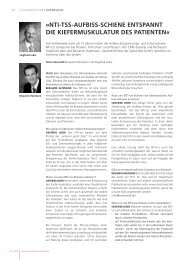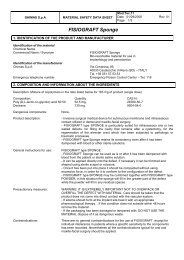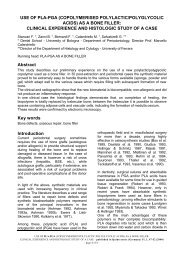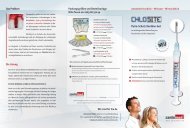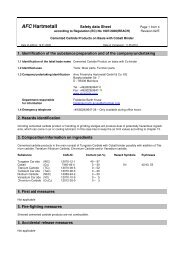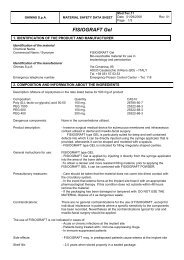MSDS chlo-site - Zantomed
MSDS chlo-site - Zantomed
MSDS chlo-site - Zantomed
You also want an ePaper? Increase the reach of your titles
YUMPU automatically turns print PDFs into web optimized ePapers that Google loves.
GHIMAS spa<br />
Via Cimarosa 85<br />
40033 Casalecchio di Reno<br />
Bologna<br />
Material Safety Data Sheet<br />
CHLO-SITE<br />
1. IDENTIFICATION OF THE PRODUCT AND MANUFACTURER<br />
Identification of the material<br />
Commercial Name / Synonym CHLO-SITE<br />
Identification of the manufacturer<br />
Ghimas S.p.A. Via Cimarosa, 85<br />
40033 Casalecchio di Reno (BO) – ITALY<br />
Tel. +39 051 57.53.53<br />
Emergency telephone number Emergency Poison Control Center – Tel. 118<br />
2. COMPOSITION AND INFORMATION ABOUT THE INGREDIENTS<br />
Description: Xanthan Gel containing <strong>chlo</strong>rhexidine<br />
Mod. Tec. 11<br />
Date 11/27/2008<br />
Rev. 01<br />
Pag. 3<br />
Ingredient Percentile CAS ENEICS Danger Symbol Risk Code<br />
Xanthan gum 2,50% 11138-66-2 234-394-2 -- --<br />
Chlorhexidine Dihydro<strong>chlo</strong>ric 1.00% 3697-42-5 223-026-6 Xi 36-37-38<br />
Chlorhexidine Digluconate (solution<br />
20% in water)<br />
2,50% 18472-51-0 -- -- --<br />
Deionized water 96.00% 7732-18-5 -- -- --<br />
R36-37-38: Irritant to the eyes<br />
3. HAZARDS IDENTIFICATION<br />
Dangerous components: None when utilized as instructed<br />
4. FIRST-AID MEASURES<br />
- Contact with the eyes:<br />
Rinse immediately with plenty of water for at least 10 minutes.<br />
- Contact with the skin:<br />
Wash immediately with plenty of water and soap<br />
- If ingested:<br />
If ingested in small quantities will not provoke and disturbances. If ingested in large quantities do not induce<br />
vomiting, drink a lot of water and seek medical advice immediately showing them the <strong>MSDS</strong> for the product.<br />
- If inhaled:<br />
If inhaled remove the person to a well ventilated area. If they are having trouble breathing, seek medical advice<br />
immediately.<br />
5. FIRE FIGHTING MEASURES<br />
- Extinguish with any normal fire extinguishing device (water, carbon dioxide, powder or foam), according to the<br />
materials involved in the fire.<br />
- Extinguishing devices not to use: no contraindications for using any devices<br />
- Risk of combustion: None<br />
- Avoid breathing any fumes.<br />
- Protective equipment for firefighters<br />
- No special equipment is required, use the normal protective measures for these circumstances
6. ACCIDENTAL LEAKS AND SPILLAGE<br />
Personal precautions:<br />
Take any necessary measures to reduce to a minimum direct contact with the eyes and skin.<br />
Care should be taken when gathering the spilled material. Thoroughly wash the interested area and follow the<br />
standard procedure for disposal of chemical products.<br />
7. HANDLING AND STORAGE<br />
Precaution when handling the material:<br />
Avoid contact with the eyes, skin and clothing. Avoid prolonged or repeated exposure.<br />
Incompatible materials:<br />
None in particular<br />
Storage conditions:<br />
Conserve in the original packaging material, in a cool, dry area. Conservation in a refrigerated area will however slow<br />
the degradation process.<br />
Special Conditions:<br />
Material is sensitive to light<br />
8. EXPOSURE CONTROLS AND PERSONAL PROTECTION<br />
Personal protection:<br />
- Protection of the respiratory tract: none when used under normal conditions<br />
- Protection of the hands: protective gloves<br />
- Protection of the eyes: protective glasses for chemical agents<br />
- Protection for the skin: it is recommended to use a normal laboratory apron<br />
- Limits to exposure: NONE<br />
9. CHEMICAL AND PHYSICAL PROPERTIES<br />
Physical state: Gel<br />
Color: White<br />
Odor: Odorless<br />
Solubility in water: Degrade over a period of time<br />
10. STABILITY AND REACTIVITY<br />
Conditions to avoid:<br />
Stabile under normal conditions<br />
Substances to avoid:<br />
Avoid contact with strong alkalies<br />
Dangers from decomposition:<br />
NONE<br />
11. TOXICOLOGICAL INFORMATION<br />
TLV: Not available<br />
Type of exposure:<br />
Inhalation: Can cause irritation to the mucosa and the upper respiratory via<br />
Ingestion: Can cause irritation
Skin absorption: Can cause irritation<br />
12. ECOLOGICAL INFORMATION<br />
Observe the normal environmental regulations regarding handling and treating chemical products<br />
13. WASTE DISPOSAL<br />
Dispose of in accordance with the current regulations regarding the disposal of chemical products.<br />
14. TRANSPORT INFORMATION<br />
Not considered dangerous according to the regulations regarding transport<br />
Transport by LAND and RAIL: No particular precautions must be taken<br />
Transport by SEA: No particular precautions must be taken<br />
Transport by AIR: No particular precautions must be taken<br />
15. NATIONAL REGULATIONS AND REFERENCES<br />
Not considered dangerous according to the regulations stated in the 1999/45/CE directive and successive updates<br />
16. OTHER INFORMATION<br />
The information contained in this technical data sheet are the result of information that was<br />
available at the time this was written. It refers solely to the indicated product and does not<br />
constitute any form of guarantee. The person using the material is obliged to assure the<br />
correctness and completeness of this information in relation to the specific use that is to be made<br />
of the product. The manufacturer assumes no responsibility for damage to persons or things<br />
derived from an improper use of the product on the basis of the information provided in this<br />
document. This sheet null and voids and substitutes all previous editions.






